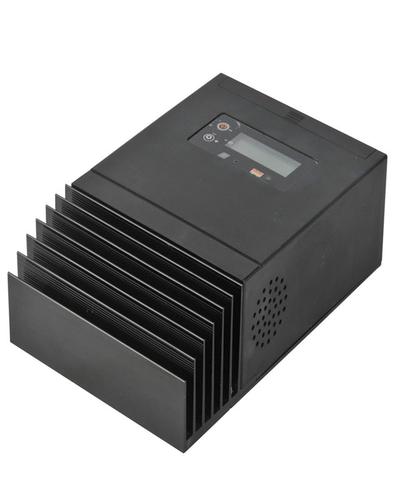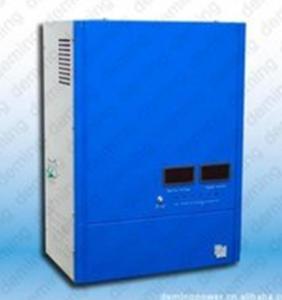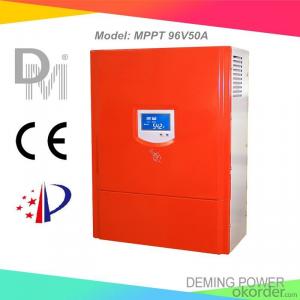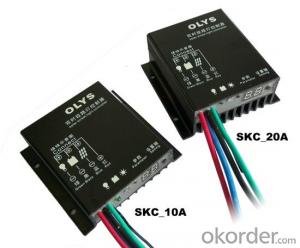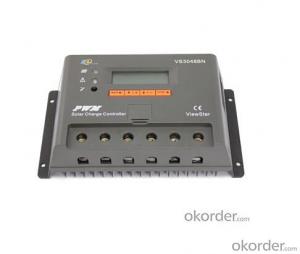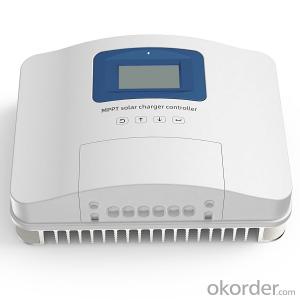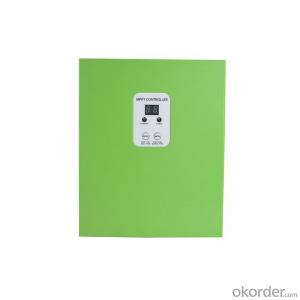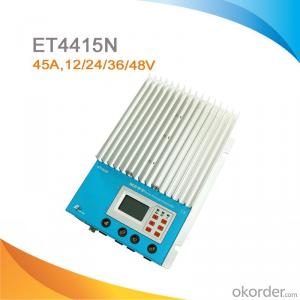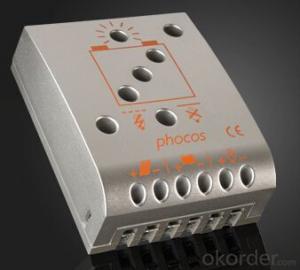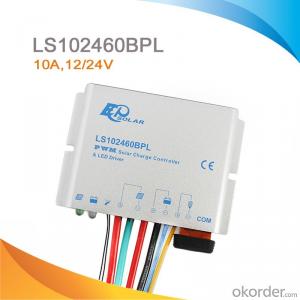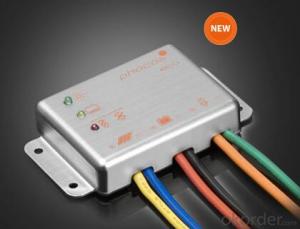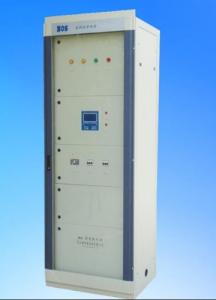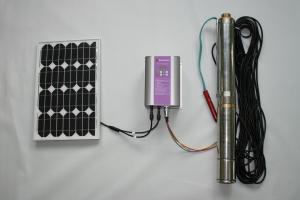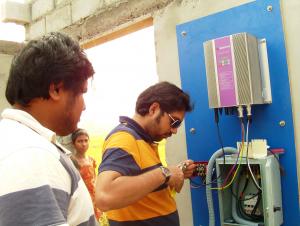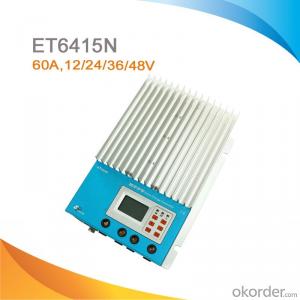SUN-MPPT-5015A Solar charge controller 50A
- Loading Port:
- Ningbo
- Payment Terms:
- TT or LC
- Min Order Qty:
- 20 pc
- Supply Capability:
- 10000 pc/month
OKorder Service Pledge
OKorder Financial Service
You Might Also Like
1. Overview
Thank you for selecting the MPPT solar charge controller.
The MPPT is essentially a smart DC to DC converter which has been optimized to harvest maximum energy from the PV array in battery based solar electric systems by using a variety of maximum power point tracking (MPPT) strategies.
The controller’s secondary objective is to ensure that the batteries receive a full charge without becoming overcharged.
This is accomplished through a four stage charging process.
Please take the time to read this operator’s manual and be familiar with the controller.
This will help you make full use of the many advantages the MPPT can provide for your PV system.
2. Features
1 - Battery Status LED Indicator:An LED indicator that shows battery status or system errors.
2 - Charging Status LED Insdicator:An LED indicator that shows charging status and overvoltage of pv.
3 - Setting Button1:Set load work mode,battery type and max charge current.
4 - Setting Button2:Set load work mode,battery type and max charge current(in manual mode used for load ON/OFF).
5 - LCD Digital Display:Dispaly the system status
6 - Wiring Box Cover:Sheet metal wiring box cover protects power connections
7 - FAN:FAN to dissipate Internal circuit heat
8 - Heatsink:Aluminum heatsink to dissipate controller heat
9 - Mounting Hanger:Keyhole slot for mounting
10 - Solar Module Terminals:Connect solar modules
11 - Battery Terminals:Connect batteries
12 - Load Terminals:Connect loads
13 - RJ45 Communication Interface:Communicate with personal computer
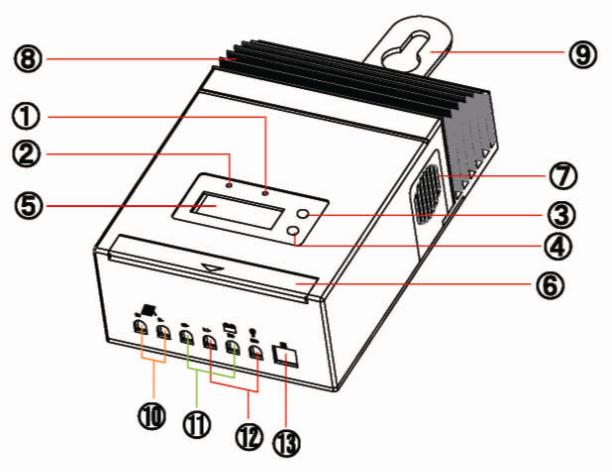
The mounting location is important to the performance and operating life of the controller. The environment must be dry and protected from water ingress. If required, the controller may be installed in a ventilated enclosure with sufficient air flow. Never install the MPPT unit in a sealed enclosure. The controller may be mounted in an enclosure with sealed batteries, but never with vented/ flooded batteries. Battery fumes from vented batteries will corrode and destroy the MPPT circuits. Multiple MPPT can be installed in parallel on the same battery bank to achieve higher charging current. Additional parallel controllers can also be added in the future. Each MPPT must have its own solar array.
CAUTION: Equipment Damage or Risk of Explosion
Never install the MPPT in an enclosure with vented/Flooded batteries. Battery fumes are fl ammable and will corrode and destroy the MPPT circuits.
CAUTION: Equipment Damage
When installing the MPPT in an enclosure, ensure suffi cient ventilation. Installation in a sealed enclosure will lead to over-heating and a decreased product lifetime.
NOTE : Mounting
When mounting the MPPT ,ensure free air through the controller heat sink fins. There should be at least 150mm of clearance above and below the controller to allow for cooling. If mounted in an enclosure, ventilation is highly recommended.
3. Specifications
Electrical
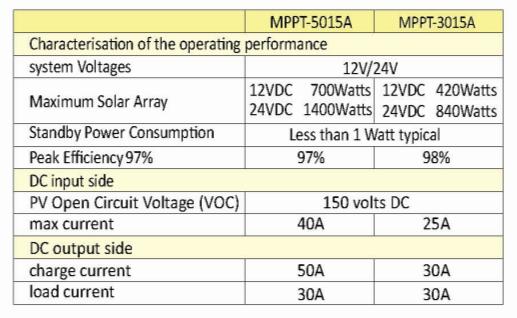
NOTE:
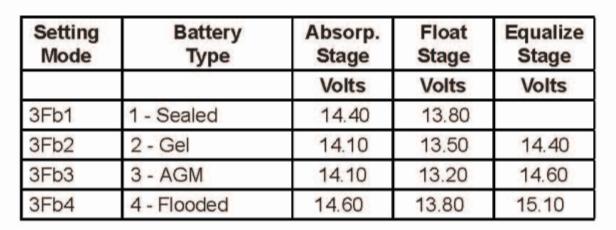
All charging voltage setpoints listed are for 12 Volt systems. Multiply 2X for 24 Volt systems.
Battery Charging Charging algorithm 4 - stage Charging stages Bulk, Absorption, Float, Equalize Temperature compensation coeffcient -5 mV / °C / cell (25 °C ref.) Temperature compensated setpoints Absorption, Float, Equalize, HVD Charging Setpoints
- Q: What is the maximum current a solar controller can deliver to a load?
- The maximum current a solar controller can deliver to a load depends on the specifications of the controller itself. It varies from controller to controller, and can range anywhere from a few amps to several hundred amps, depending on the size and capacity of the controller.
- Q: How does a solar controller handle battery under-voltage disconnect recovery?
- A solar controller handles battery under-voltage disconnect recovery by monitoring the battery voltage and disconnecting the load when the voltage drops below a certain threshold. Once the battery voltage recovers and reaches a safe level, the solar controller re-connects the load to ensure the battery is protected from further discharge.
- Q: Can a solar controller be used with solar-powered well pumps?
- Solar-powered well pumps can indeed be used in conjunction with a solar controller. This particular device plays a crucial role in the functioning of a solar power system, as it is responsible for regulating the charging and discharging of batteries. By doing so, it ensures that the system operates efficiently and safely. When it comes to solar-powered well pumps, the solar controller takes on the additional responsibility of controlling the power flow from the solar panels to the pump. Its primary function is to prevent the batteries from becoming overcharged or drained. Furthermore, the solar controller helps optimize the pump's performance by ensuring that the power generated by the solar panels is used effectively. To enhance the overall efficiency and longevity of the system, it is highly recommended to incorporate a solar controller when using solar-powered well pumps.
- Q: How do I know if my solar controller is working properly?
- To determine if your solar controller is functioning properly, you can perform a few simple checks. Firstly, check if the controller's display is showing the expected information, such as battery voltage, charging status, or load settings. Secondly, verify that the controller is connected to the solar panels and battery system securely. You can also examine the controller for any physical damage or loose connections. Lastly, monitor if the controller is effectively regulating the charging and discharging of your batteries. If it appears to be correctly managing the power flow and maintaining the desired battery levels, then your solar controller is likely working properly.
- Q: How do you prevent overheating of a solar controller?
- There are a few ways to prevent overheating of a solar controller. Firstly, it is important to ensure that the controller is installed in a well-ventilated area, away from direct sunlight or any heat sources. Additionally, using heat sinks or fans can help dissipate excess heat from the controller. Regular maintenance, such as cleaning dust or debris from the controller, can also aid in preventing overheating. Lastly, choosing a solar controller with built-in temperature sensors and automatic shut-off features can provide added protection against overheating.
- Q: Are all solar controllers waterproof?
- No, not all solar controllers are waterproof. Some solar controllers are designed to be waterproof, while others may not be. It is important to check the specifications and features of a solar controller before purchasing to ensure that it is waterproof if that is a requirement for your specific needs.
- Q: Can a solar controller be used in a hybrid solar panel system?
- Yes, a solar controller can be used in a hybrid solar panel system. A solar controller, also known as a charge controller, is responsible for regulating the voltage and current from the solar panels to the batteries or grid. In a hybrid solar panel system, which combines both solar and other energy sources like wind or grid electricity, a solar controller is still necessary to manage the charge from the solar panels. It helps ensure that the batteries are properly charged and protected from overcharging or excessive discharging. Additionally, a solar controller can also monitor and optimize the energy flow between the different energy sources in a hybrid system, maximizing the efficiency and utilization of the solar power generated.
- Q: How does a solar controller handle reverse current flow from batteries to solar panels?
- A solar controller, commonly referred to as a charge controller, plays a vital role in solar power systems. Its main function is to regulate the flow of charge from solar panels to batteries, ensuring optimal charging and preventing any harm or overcharging to the batteries. To address the issue of reverse current flow from batteries to solar panels, a solar controller employs either a blocking diode or a solid-state relay. These components are specifically designed to hinder the flow of current in the opposite direction, thereby safeguarding the solar panels against potential damage caused by the discharge of the batteries. The blocking diode serves as an electricity valve, permitting the current to flow from the solar panels to the batteries while blocking any reverse current. Installed in the wiring between the batteries and solar panels, it effectively prevents the battery discharge from flowing back into the panels. Similarly, more advanced solar controllers can incorporate a solid-state relay. These relays utilize electronic switching components to control the direction of current flow. In instances of reverse current, the solid-state relay promptly detects and thwarts it from reaching the solar panels. By incorporating either a blocking diode or a solid-state relay, a solar controller effectively mitigates the risk of reverse current flow from batteries to solar panels. This ensures the durability and efficiency of the solar power system by maintaining the intended energy flow and shielding the panels from potential damage.
- Q: How do I protect a solar controller from power surges?
- To protect a solar controller from power surges, you can use a surge protector or a surge suppression device. These devices are designed to divert excess voltage away from your controller and prevent damage caused by power surges. Make sure to select a surge protector that is specifically rated for solar applications and install it between the solar panels and the controller. Regularly inspect and maintain the surge protector to ensure its effectiveness in safeguarding your solar controller.
- Q: Can a solar controller be used with solar panels of different weights?
- Yes, a solar controller can be used with solar panels of different weights. The purpose of a solar controller is to regulate the flow of electricity from the solar panels to the battery or load. It does not depend on the weight of the solar panels. The main factors to consider when using a solar controller are the voltage and current ratings of the panels, which should be within the specifications of the controller. As long as the voltage and current ratings are compatible, the solar controller can be used with solar panels of different weights.
Send your message to us
SUN-MPPT-5015A Solar charge controller 50A
- Loading Port:
- Ningbo
- Payment Terms:
- TT or LC
- Min Order Qty:
- 20 pc
- Supply Capability:
- 10000 pc/month
OKorder Service Pledge
OKorder Financial Service
Similar products
Hot products
Hot Searches
Related keywords

